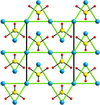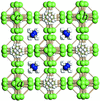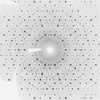issue contents
December 2017 issue

Cover illustration: Portion of a twofold reciprocal-space section reconstructed from synchrotron single-crystal XRD data for i-Yb15.5Cd68.4Mg16.1 quasicrystal, see Yamada et al. [(2017). Acta Cryst. B73, 1127-1143].
lead articles
Open  access
access
 access
accessVariations in mean bond length are examined in oxide and oxysalt crystals for 55 cation configurations bonded to O2−. Bond-length distortion is confirmed as a statistically significant causal factor of mean bond-length variation. The assignment of a coordination-based radius to O2− is found not to be supported by experimental data.
research papers
Download citation


Download citation


Iridium(III) dimethyl sulfoxide complexes, analogues to clinically significant metallodrugs, exhibiting different rotamers in their solid-state structures are investigated. The effect of the amount of the crystallized water and the hydrogen-bonded network in their supramolecular structures on the conformational preferences is studied.
The Ni2In phase of Li2S (P63/mmc), recently observed at 30 GPa as the final step in the transition antifluorite→anticotunnite→Ni2In, provides evidence of the oxidation–pressure concept, since the [Li2S] subarray of the high-pressure phase of Li2SO4 (Cmcm) is a distortion of the new Li2S phase. Following the extended Zintl–Klemm concept (EZKC), Li2S can be formulated as Li+[LiS]– ≡ Li+[Ψ-BeS] and its usefulness has been enhanced by calculating the values of the ionic strength I. The enhancement factor, S = I[Ψ-BeS]/I[Li2S] = 1.16, denotes increased stability in [Ψ-BeS] as brought about by the EKZC.
Ionic stregth (I) calculations on 25 silicates indicate that the I values of the Zintl polyanions are higher than those of the original compound. The extended Zintl–Klemm concept is reinforced by the application of the thermodynamically related ionic strength, I.
Download citation


Download citation


Hitherto unknown crystal structures of β- and α-Sr2B2O5 are presented and a unified description of the Sr2B2O5 modifications based on the formalism of commensurately modulated structures is created. Data of the γ ↔ β ↔ α′ ↔ α thermal phase transitions are revisited and extended.
Download citation


Download citation


The high-pressure behaviour of monoclinic phosphoric acid is presented and a new high-pressure orthorhombic phase is reported. The molecule–molecule interaction energies of the orthorhombic phase are shown to be more attractive than those of the low-pressure monoclinic phase.
Download citation


Download citation


Diffraction patterns of norleucine frequently show diffuse streaks, which indicates a stacking disorder of the double layers. The disorder is explained by symmetry analysis and lattice-energy minimizations using DFT-D.
CCDC reference: 1570080
Download citation


Download citation


The high-temperature elpasolite-like crystal structure of (NH4)3VOF5 with six spatial orientations of the VOF53− octahedron undergoes an order–disorder phase transition with the existence of two octahedral dynamic states at room temperature.
Microstructural analysis of the room-temperature synchrotron X-ray diffraction (XRD) data of lead magnesium niobate samples prepared under different processing conditions has been carried out using the Rietveld method to study the polar nanoregions (R3m phase). This is the minor phase and normally not accessible at room temperature using laboratory-source XRD data. It is found that the Gaussian component of size broadening is apposite for the polar rhombohedral phase (R3m) and the Lorentzian component of strain broadening is apposite for the paraelectric cubic phase (Pm m).
m).
Download citation


Download citation


The single-crystal structure of [K0.43(NH4)0.57]3H(SO4)2 has been determined using X-ray diffraction; its dielectric properties have been studied to define the structural influence on the abnormal physical properties.
CCDC reference: 1573140
Download citation


Download citation


Structure determinations of the title compounds at different temperatures revealed the presence of a moderate, though still strong, O—H⋯N/O⋯H—N hydrogen bond in which the electron density distribution of its bridging hydrogen is temperature dependent. The structural properties of the anions [PO3F]2− and [HPO3F]−, namely the interdependence of the longest P—F and P—O bond lengths, which reflects the bonding of the latter anion, are also discussed.
Download citation


Download citation


A systematic study of the structures of ternary icosahedral Yb–Cd–Mg quasicrystals with different Mg contents has been carried out by single-crystal X-ray diffraction; occupational and positional disorder in the resulting structures was compared with that in a Yb–Cd–Mg 1/1 approximant.
CCDC reference: 1575042
Download citation


Download citation


Structural investigation of Rb2Ti2O5 was carried out using X-ray diffraction, Raman spectroscopy along with calculations of phonon modes using DFT.
Download citation


Download citation


Fully hydrogenated glycolide (C4H4O4) has been studied as a function of pressure on the high-pressure beamline, PEARL, at ISIS Neutron and Muon Source. It undergoes a phase transition but remains monomeric to 6 GPa.
Download citation


Download citation


Accurate structural parameters of Mg2Si and Mg2Sn are reported. They are useful for studying these promising thermoelectric materials and their solid solutions.
CCDC references: 1577026; 1577027; 1577028; 1577029; 1577030; 1577031; 1577032; 1577033; 1577034; 1577035; 1577036; 1577037; 1577038; 1577039; 1577040; 1577041; 1577042; 1577043; 1577044; 1577045; 1577046; 1577047; 1577048; 1577049; 1577050; 1577051; 1577052; 1577053; 1577054; 1577055; 1577056; 1577057; 1577058; 1577059; 1577060; 1577061; 1577062; 1577063; 1577064; 1577065; 1577066; 1577067
The microscopic order parameter, which is responsible for the physics of high-Tc superconductors, especially the insulator–metal transition and the metal–superconductor transition, is the local field that reflects interlayer polarization.
Download citation


Download citation


At ambient temperature, the H atom in the short intramolecular hydrogen bond of 3-(pyridin-4-yl)pentane-2,4-dione is disordered; below 50 K, a structural phase transition and proton ordering are observed.
Download citation


Download citation


X-ray and computational study of cis- and trans-diketopiperazines of N-methyl-phenylalanine with the thia-pipecolic acids and thia-prolines are presented. The effect of sulfur on the geometry of diketopiperazine ring and amide bond non-planarity is discussed.
book reviews
Free 

Free 

Free 



 journal menu
journal menu










































